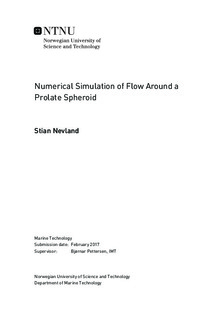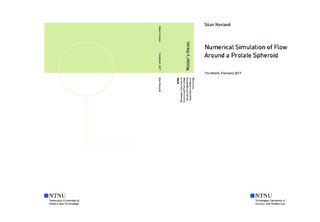| dc.description.abstract | The concept of closed containment fish cages is promising when coping with sea lice and
escaped fish challenges in the aquaculture industry. Unlike the traditional open net cages,
the external flow caused by current and waves has to flow entirely around the fully closed
walls. Hence, the importance to consider the hydrodynamic loads, as well as the behavior of
the disturbed flow.
In the present study, a closed containment fish cage has been simplified as a (LR = L/D
= 4/3) prolate spheroid. The model is assumed fully submerged in a steady current, and
oriented with its major axis normal to the incoming flow. The flow has been simulated numerically
by a finite volume method in the software OpenFOAM for five different Reynolds
numbers, Re = 100, 200, 250, 300 and 500. The resulting pressure, velocity and vorticity
fields are presented using various visualization techniques, whereas quantities related to hydrodynamic
force coefficients, separation and vortex shedding frequencies are computed. Due
to the low aspect ratio, the main goal of the present study was to relate the present results
to flow features appearing in the wake of a sphere.
For the two lowest Reynolds numbers Re = 100 and 200, the flow was found to be steady
and symmetric in the major plane. At the former Re, a similar planar symmetry aligned
with the minor plane of the prolate spheroid was observed. The flow separates and rejoins a
certain distance downstream. A maximum separation length equal to Ls = 1.26D and 1.75D
was obtained for Re = 100 and 200, respectively.
An unsteady wake flow was apparent for Reynolds numbers Re 250, with consequent
oscillating hydrodynamic forces. At Re = 250, a pair of counter-rotating vortices were found
to twist around each other as they propagate downstream. The most striking discovery,
relating the present results to the flow around a sphere, is the periodic shedding of hairpin-shaped
vortices of constant orientation, at Re = 300. The topology of the vortical structures,
as well as the associated shedding frequency, were found to coincide with the results of a
sphere. A planar symmetry is evident and aligned with the major axis of the LR = 4/3
prolate spheroid. As a Reynolds number of Re = 500 is reached, the symmetry features of
the wake are lost. Unlike the vortex structures of fixed orientation at Re = 300, the present
visualizations at Re = 500 revealed a chaotic wake of alternately shed vortices. The dominant
shedding frequency in terms of Strouhal number, St = 0.137 and 0.183, were found for Re
= 300 and 500, respectively.
The resemblance between the results of the LR = 4/3 prolate spheroid and the sphere
was found to be strong concerning hydrodynamic force coefficients and separation. At Re =
300 an averaged drag and lift coefficient of 0.664 and 0.052 were computed after
the flow had reached a steady state. For increasing Re, the point of separation was found to
move upstream. The separation angle from the front stagnation point in the middle minor
plane decreased from 121 at Re = 100 to 103 at Re = 500.
The outline of the wake 1D behind the prolate spheroid was found to maintain its projected
area at all Re. However, at the two highest tested Reynolds numbers, the major axis
of the wake was found to rotate and align with the minor axis of the prolate spheroid, somewhere
between 4D and 7D downstream. A comparable axis switching phenomenon has been
reported for similar asymmetric bodies as a LR = 6 prolate spheroid and LR = 3 elliptic disk.
Therefore, the present results indicate that flow features appearing in the wake of a sphere are maintained for the low aspect ratio (LR = 4/3) prolate spheroid, at the tested Re.
However, the presence of an asymmetric cross-section is seen to introduce similarities toward
results of higher aspect ratio bluff bodies.
For further work, it is recommended to increase the practical relevance of the numerical
simulations. This may be done by increasing the Reynolds number to simulate turbulent
flow or change the boundary conditions to introduce e.g. a free surface or a shallow water
condition. | |

